No, you are viewing it solely through a regional lens, and dismissing more local concerns because you aren’t willing to view it through a more local lens.
Ok, but...I'm not. Do I need to go through town by town and explain it in 173 different ways? Something only becomes a regional issue because it is impacting a significant number of localities. That doesn't suddenly mean it's no longer happening at the local level, in fact just the opposite, it's happening at the local level in a great number of localities.
I'll give one demonstrative example; Sudbury.
Sudbury was a rural farming community up until the post-war suburbanization boom when, "town character" be damned, the middle class was going to get their single family sprawl. Sudbury's population almost tripled between 1950-1960 and then nearly doubled again between 1960-1980. Sudbury, like the region, had its "character" massively changed during this time period from a farming community to a middle class commuter community. Then it stopped. Which is probably a good thing, because the 1950s-1980s style of development was environmentally and financially unsustainable.
Between 1980-today, the character has again undergone a massive change. It's no longer a middle class commuter community, it's an upper class older community grappling with the demographic crisis of plummeting school enrollment (when I last worked for Sudbury, in 2021, they were projecting a 25% decline in enrollment by 2025) because people who grew up in Sudbury could no longer afford to live there into adulthood. Just because a similar story is playing out in municipalities across the region does not mean it's not a local issue.
While I haven't done polling, I'd also be pretty confident the majority of Sudbury residents would also oppose building significant new apartments. Sudbury's experience with MFH is Avalon, one of the worst developers I've ever encountered, the kings of auto-oriented density.
The area between Avalon and Raymond Rd is only about 0.75 square miles. It holds MFH, multiple grocery stores, some surprisingly good restaurants (highly recommend Farmer's Daughter), a variety of retail options, day care, entertainment and cultural amenities, and a long stalled rail trail that will get built eventually. Yet the idea of living even car-lite in the multi-family housing is silly, because walking to any of that sucks. So we dump yet more cars onto Rt. 20.

But that was not inevitable, and that's not the fault of the density, that's the fault of the way in which this area, which as the crow flies is a perfectly walkable distance, was developed. If this were developed more in keeping with the traditional town character of Sudbury, as a village center, it would not only be a much more pleasant area, it would probably make sense to have an MWRTA bus running between it and the Framingham train station. But Sudbury decided that town character doesn't apply to Rt. 20 development. So they get this. I would agree with them that more of this is hardly desirable. But the form it takes is up to them, they don't have to choose more of this.
So then, if the technical form the MFH takes is not in conflict with Sudbury's character, at least certainly not to the degree the modern character is at conflict with the 1950-1980 character or the pre-ww2 character, what is the opposition about?
I think it's time we talk about the real elephant in the room here, that most of the critics of the law have a vested financial interest in the crisis. Bringing the state's median home price back to the 1980 level ($193,565 in 2024 dollars) would be an unprecedented financial disaster for hundreds of thousands if not millions of families. That's not acknowledged enough by any side in the debate, because it makes the homeowners sound self interested and it makes the state sound heartless. This is the gordian knot at the heart of the issue and everything else we're arguing about is window dressing.
In 1980, 20.2% of the state's residents made enough money to buy a home in Belmont. 15.3% made enough to buy a home in Wellesley. By 1990 that was already down to 3.2% and 1.9%, respectively. (
source - Federal Reserve Bank of Boston, 1995). That is changing the character of a community. This is a very small, inadequate step towards course correction. It has to be that way because the state (and federal government) has no idea how to solve the real gordian knot, untying the need for perpetually rising housing costs as a basis for middle class retirement and maintaining housing affordability for access to the middle class in the first place. This dynamic plays out locally with its own unique quirks in every town and city. Those quirks don't make this not a regional issue, and it being a regional issue does not make it any less local and personal.

